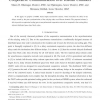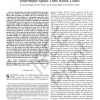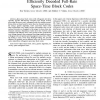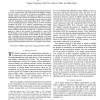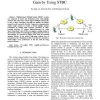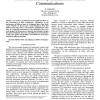TWC
2010
14 years 2 months ago
2010
In this paper, we propose a TDMA based simple transmission scheme, which overcomes the effect of the delays caused by the poor synchronization of the relaying nodes over Ricean ch...
TIT
2010
14 years 2 months ago
2010
In this paper, collocated and distributed space-time block codes (DSTBCs) which admit multigroup maximum-likelihood (ML) decoding are studied. First, the collocated case is conside...
TCOM
2010
14 years 2 months ago
2010
Space-time block codes with orthogonal structures typically provide full-diversity reception and simple receiver processing. However, rate-1 orthogonal codes for complex constellat...
TWC
2008
14 years 7 months ago
2008
The blind recognition of communication parameters is a key research issue for commercial and military communication systems. The results of numerous investigations about symbol tim...
ENGL
2007
14 years 7 months ago
2007
— Multiple-Input Multiple-Output (MIMO) systems are composed of source and destination nodes with multiple antennas. But, when nodes cannot support multiple antennas due to size ...
CORR
2007
Springer
14 years 7 months ago
2007
Springer
It is well known that Space-Time Block Codes (STBCs) obtained from Orthogonal Designs (ODs) are singlesymbol-decodable (SSD) and from Quasi-Orthogonal Designs (QODs) are double-sy...
VTC
2006
IEEE
15 years 1 months ago
2006
IEEE
— The combination of space-time block codes (STBC) and spatial multiplexing (SM) schemes has the advantages of diversity gain and high data rate. For such STBC/SM hybrid systems,...
GLOBECOM
2006
IEEE
15 years 1 months ago
2006
IEEE
Abstract— ABBA codes are an important class of quasiorthogonal space-time block codes proposed by Tirkkonen et al.. Recently, they have become more attractive for practical appli...
ICC
2007
IEEE
15 years 1 months ago
2007
IEEE
Abstract—A new 4 × 1 scheme of transmitting two real orthogonal space-time block codes (O-STBC) on the I- and Q-channels with pulse-shaped offset QAM is proposed. This scheme ac...
PIMRC
2008
IEEE
15 years 1 months ago
2008
IEEE
— In receivers, IQ imbalances have significant effects on the performance of data transmission. Comparison of the performance of different types of Orthogonal Space-Time Block Co...
